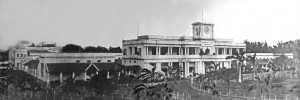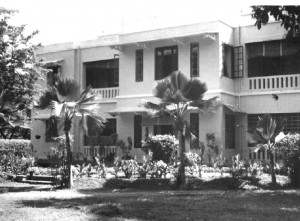Registered with the Registrar of Newspapers for India under R.N.I 53640/91
Vol. XXVI No. 19, January 16-31, 2017
Our Readers write
Naming it right
Several readers have pointed out that we made a howler with the publication of the feature on JJ Road (MM, January). They tell me that it is a road not named after the late Chief -Minister and long pre-dates her. Tara Murali, who lives off the road, writes:
It is definitely not named after J. Jayalalithaa.
A narrow kutcha private road existed there till the early 1970s when the Madras Corporation wanted to make it into a pucca Corporation road of greater width. Land from adjoining plots was acquired for this purpose.
The Corporation officials in this process of acquisition used to refer to it as JJ Road for they said, it came on the JJ grid of Jagampet’s house on the other side of Kasturi Ranga Road, is unclear.
The road was called JJ Road long before J. Jayalalithaa -entered politics.
Tara Murali
tara.murali1@gmail.com
‘The place where I was born’
My long-awaited return to Madras, as I will always think of it, was scheduled for the day after Cyclone Vardah ran roughshod through the region and left a wide swath of jaw-dropping devastation. In Delhi, awaiting our flight to Chennai, my friend and I wondered whether we would be able to realise our plan to visit the city where I was born 68 years ago; it seemed thoroughly improbable, and communication with friends and hotels in Tamil Nadu had become nearly impossible. Yet, somehow Indians’ remarkable ability to carry on in the face of hardship and even disaster prevailed, and we found our flight and our lodgings ready to accommodate us. Thanks to the efficiency and grace of our hosts, Vardah had failed to foil us.
 The Christina Rainy Hospital as it once was… and as it is today.
The Christina Rainy Hospital as it once was… and as it is today.
Along with a tourist’s general interest in seeing some of the sights of the region – an interest gratified by visits to Kapaleeswarar Temple, Fort St. George, and St. Thomas basilica, as well as the World Heritage sites at Mahabalipuram – I had a prodigal son’s desire to find and experience places of particular importance in my life and that of my parents during my earliest days. Of those days, I had no first hand memory, -having departed from Madras with my American mother and father at the age of 20 months. But from my birth certificate and my mother’s scrapbook, I knew that I was born at Christina Rainy Hospital; that I lived at 14 Casa Major Road; and that my parents spent many happy hours at the Adyar Club, now merged with and bearing the name of the Madras Club, but occupying the same genteel premises shown in my mother’s photographs.

Thanks to the editor of this journal, with whom I had the good fortune of being put in touch by his niece and a mutual friend, both Indians living quite near me in New England, we were able to spend a most enjoyable two hours at the Madras Club. It was delightful to learn that the property was practically unchanged since my mother and father, who was U.S. Vice Consul in Madras in 1948–50, attended numerous parties and functions there. I was able to picture them entering the stately rotunda under the starry domed ceiling and dining, dancing, and playing billiards in the stately rooms of the club. The realisation that this had been, like practically all such establishments of the time, a “Whites Only” club was embarrassing, but made the experience only somewhat bittersweet. A fine pot of tea and a serving of exquisite samosa-s on the terrace brought this wonderful experience to a close.

For the following day, I had hired a private tour guide and driver to enable me to reach my remaining objectives. Regarding my first home on Casa Major Road, I owe thanks to Mrs. Elizabeth Abraham, had read about my prospective visit in The Hindu’s “Madras Miscellany” column and got word to me. She related that she had lived next door at number 15 from 1954–1966, and she was able to pinpoint the location (street numbers having been changed) near the junction of Pantheon Road. Sadly, the handsome house of which I have a picture, which I assume was leased by the American Consulate as a staff residence, is no longer there, though I suspect some portions of the structure may remain within the walls of newer buildings set back from the street. I walked the length of Casa Major Road and tried to imagine living in this same neighbourhood as a baby – though in my imagination, it was a far more tranquil scene than that of the crowded, noisy thoroughfare that I found in 2016.

Next, we set out for the hospital. A communication glitch made this adventure longer and more complicated than it might otherwise have been, as our tour guide mistook ‘Rainy’ for ‘Railway,’ with the result that we went first to an -altogether different facility from the one where my mother gave birth to me. Although the -detour did offer interest, as we got a glimpse of the area where railway coaches are still -manufactured, it was Christina Rainy Hospital that I was eager to see. And after another 45 minutes of navigating through streets clogged with traffic, we did in fact arrive there.
To be honest, I must say that I expected this pilgrimage to have a fairly anticlimactic outcome – no doubt I would find merely a nondescript complex of utilitarian buildings, differing only in my own imagination from any other 21st -Century hospital. But the scene that awaited me was far more poignant. For reasons that I can only guess at, but for which I am grateful, the authorities had seen fit to leave in place the -dilapidated building that housed patients at mid-20th Century. The weary old edifice surely looked even more than usually forlorn for having absorbed a heavy body blow from Vardah two days earlier, yet it stood placidly waiting to welcome this wide-eyed returning alumnus. The fact that my return took place on my 68th birthday amplified the emotional impact that I felt.
Stephen Spaulding
Hollis, New Hampshire, USA

